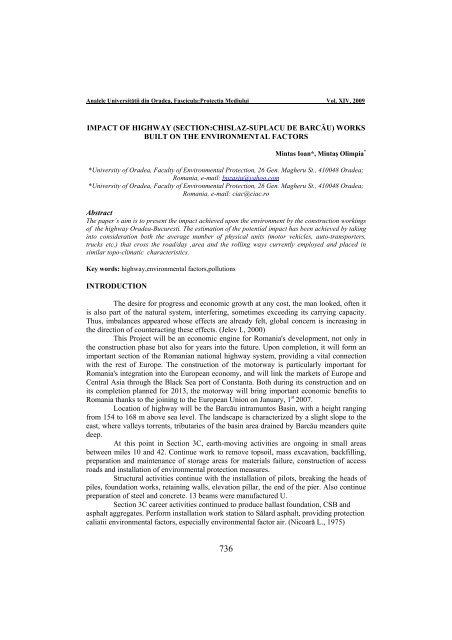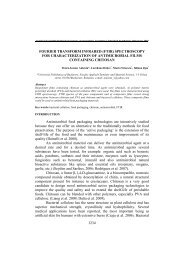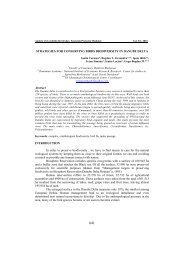ANALELE UNIVERSITĂŢII DIN ORADEA Fascicula Pr
ANALELE UNIVERSITĂŢII DIN ORADEA Fascicula Pr
ANALELE UNIVERSITĂŢII DIN ORADEA Fascicula Pr
Create successful ePaper yourself
Turn your PDF publications into a flip-book with our unique Google optimized e-Paper software.
Analele Universităţii din Oradea, <strong>Fascicula</strong>:<strong>Pr</strong>otecţia Mediului Vol. XIV, 2009<br />
IMPACT OF HIGHWAY (SECTION:CHISLAZ-SUPLACU DE BARCĂU) WORKS<br />
BUILT ON THE ENVIRONMENTAL FACTORS<br />
736<br />
Mintas Ioan*, Mintaş Olimpia *<br />
*University of Oradea, Faculty of Environmental <strong>Pr</strong>otection, 26 Gen. Magheru St., 410048 Oradea;<br />
Romania, e-mail: buzasiu@yahoo.com<br />
*University of Oradea, Faculty of Environmental <strong>Pr</strong>otection, 26 Gen. Magheru St., 410048 Oradea;<br />
Romania, e-mail: ciac@ciac.ro<br />
Abstract<br />
The paper’s aim is to present the impact achieved upon the environment by the construction workings<br />
of the highway Oradea-Bucuresti. The estimation of the potential impact has been achieved by taking<br />
into consideration both the average number of physical units (motor vehicles, auto-transporters,<br />
trucks etc.) that cross the road/day ,area and the rolling ways currently employed and placed in<br />
similar topo-climatic characteristics.<br />
Key words: highway,environmental factors,pollutions<br />
INTRODUCTION<br />
The desire for progress and economic growth at any cost, the man looked, often it<br />
is also part of the natural system, interfering, sometimes exceeding its carrying capacity.<br />
Thus, imbalances appeared whose effects are already felt, global concern is increasing in<br />
the direction of counteracting these effects. (Jelev I., 2000)<br />
This <strong>Pr</strong>oject will be an economic engine for Romania's development, not only in<br />
the construction phase but also for years into the future. Upon completion, it will form an<br />
important section of the Romanian national highway system, providing a vital connection<br />
with the rest of Europe. The construction of the motorway is particularly important for<br />
Romania's integration into the European economy, and will link the markets of Europe and<br />
Central Asia through the Black Sea port of Constanta. Both during its construction and on<br />
its completion planned for 2013, the motorway will bring important economic benefits to<br />
Romania thanks to the joining to the European Union on January, 1 st 2007.<br />
Location of highway will be the Barcău intramuntos Basin, with a height ranging<br />
from 154 to 168 m above sea level. The landscape is characterized by a slight slope to the<br />
east, where valleys torrents, tributaries of the basin area drained by Barcău meanders quite<br />
deep.<br />
At this point in Section 3C, earth-moving activities are ongoing in small areas<br />
between miles 10 and 42. Continue work to remove topsoil, mass excavation, backfilling,<br />
preparation and maintenance of storage areas for materials failure, construction of access<br />
roads and installation of environmental protection measures.<br />
Structural activities continue with the installation of pilots, breaking the heads of<br />
piles, foundation works, retaining walls, elevation pillar, the end of the pier. Also continue<br />
preparation of steel and concrete. 13 beams were manufactured U.<br />
Section 3C career activities continued to produce ballast foundation, CSB and<br />
asphalt aggregates. Perform installation work station to Sălard asphalt, providing protection<br />
caliatii environmental factors, especially environmental factor air. (Nicoară L., 1975)
lso continue work on the viaduct at Suplacu Barcău largest structure along the<br />
Transylvania Motorway, which will, once completed, the highest viaduct in South-East.<br />
Viaduct is a traditional structure on piles, with a length of 1.8 kilometers and 45 openings<br />
of 40 m.<br />
The air pollution caused by motor vehicles raises two main features: first of all, the<br />
gas evacuation is being done in the proximity of the ground, which leads to large<br />
concentrations (of polluting agents) at lower altitudes, even in the case of the gases with<br />
low density and a great capacity of diffusing in the atmosphere. Secondly, the gas<br />
emissions are being produced on the entire area of the locality, the differences among<br />
concentrations depending upon the traffic level and the road (street)’ ventilation<br />
characteristics. Among the substances that lead to air pollution, composed by a large<br />
number of compounds (several hundreds), the top place is occupied by the escapement<br />
gases. (Lesnic M.,2000) The volume, the nature and the concentration of the polluting<br />
agents disseminated in the atmosphere depend on different variables as: the motor vehicle<br />
type, the nature of the fuel and the technical characteristics of the working engine. Among<br />
these polluting agents we should mention the suspension particles, brimstone dioxide, the<br />
lead, the poliflavoured hydrocarbons, the volatile organic compounds (benzene), the<br />
asbestos, the methane gas and so on.<br />
MATERIAL AND METHODS<br />
On Section 3C-Section Suplacu de Barcau, the Contractor has recommenced some<br />
structural works including 1,210 m 3 of structural concrete placed, 723 lm of piles installed,<br />
production of 666 m 3 of ballast base, 74,573 m 3 of excavation and 145,984 m 3 of fill.<br />
Contractor has also commenced the installation of U Beams at Suplacu de Barcau with 40<br />
installed this period and 21 produced. 5 T Beams have been installed during this period.<br />
The final total surface occupied by the proposed roundabout way it will be of 16.2<br />
ha. The surfaces which are going to be occupied are agricultural fields and communal<br />
woods, found in their outmost majority in private property. During the workings, a surface<br />
of about 12 ha will also be temporarily affected (occupied).<br />
The working is placed in type F seismic area with a Ks = 0.08 seismic value and<br />
with a Tc = 0.7 sec colt time.<br />
Impact Assessment of environmental factors was made based on parameters<br />
considered in the design of the topography of the affected areas and a comparison with<br />
similar works built in approximately similar relief(Barnea M.,Ursu P.,1974), (Borota D.,<br />
2000).<br />
RESULTS AND DISCUSSION<br />
The pollution type, the pollution source, the legal maximum level of pollution and<br />
the measured pollution produced by the activity are comprised in tabel 1<br />
737
The pollution type<br />
Smell<br />
Noise<br />
Atmospheric<br />
Surface, ground<br />
and soil waters<br />
The pollution<br />
source<br />
The carburant<br />
combustion<br />
process<br />
The vehicles<br />
motion<br />
The carburant<br />
combustion<br />
process<br />
Accidentally fuel<br />
losses<br />
No. pollution<br />
sources<br />
738<br />
The legal maximum<br />
level of pollution(the<br />
upper limit admitted for<br />
human beings and<br />
environment)<br />
According to the<br />
Ordinance 463/93,<br />
NTPA,Ord.708/24)<br />
Table 1<br />
The measured pollution<br />
produced by the activity<br />
and reducing and<br />
suppressing countermeasures<br />
10000 Non-mentioned Impossible to quantify<br />
10000 55dB on daylight<br />
10000<br />
Impossible to<br />
quantify<br />
-CO 80mg/mc<br />
-SO2 850mg/mc<br />
-NOX180-50mg/mc<br />
-Total powders (dust)<br />
20mg/mc<br />
VOC 50mg/mc<br />
Pb<br />
(David V., 1997)<br />
(Mintas O.,2008)<br />
In surface waters 5mg/l<br />
In ground water 5mg/l<br />
In soil < 100ppm<br />
The maximum noise<br />
level due to the auto<br />
traffic – 85dB;<br />
0.12 mg/mc<br />
0.0001 mg/mc<br />
0.0004 mg/mc<br />
0.02 mg/mc<br />
0.000001mg/mc<br />
Impossible to quantify<br />
In the case of the concentration calculus for the atmosphere polluting agents’ level<br />
the 16.2 ha field surface(occupied by the road) was taken into consideration, a 1.2 m high<br />
mixture altitude and the Corinaire values for the emission factors (agents) (Borota<br />
D.,Buzasiu O.,2000).<br />
CONCLUSIONS<br />
The susceptible substances for atmosphere infection, as a consequence of<br />
constructing highway are the combustion gases, provided both by the engines of the tools<br />
and equipments that will be employed for developing the workings proposed and by the<br />
auto means (vehicles) that will be used for materials transportation.<br />
The functioning period of the proposed variant will be marked by an increasing<br />
level of the combustion’ gases concentration (CO2, CO, N0x, SOx, COV) and of the<br />
powders and sedimentation particles. In order to secure a clean atmosphere in the close<br />
neighbourhood area of the proposed road, a stratified vegetal belt on both sides, in its safety<br />
area and parallel with the road’ axis, was planned.<br />
One can estimate that the impact of the highway upon the population is minimal or<br />
even null, due to the placement of the entire route in the outside area (extravilan) of the<br />
locality. This is a BAT recommendation.<br />
The study did not identify the location of protected targets (sensitive) located at a<br />
distance less than 1000-1500 m, or areas of interest for nature conservation (species or<br />
habitats protected).<br />
In terms of biodiversity, the area we refer to, is typical diversified development<br />
and organization of specific agroecosystems submontane zone. Species include a wide<br />
range, from cereals, technical and sunflower plants.
Agricultural areas that have a seasonal alternation coexist with areas covered with<br />
spontaneous vegetation specific mezoxerofile lawns. Shrubs of Rosa sp., <strong>Pr</strong>unus sp., Rubus<br />
sp. And Crateaeegus sp., The floor arbustiform make trecarea to special interest as Fagus<br />
silvatica forest and deciduous species specific hilly areas, alternating with patches of pine<br />
mingled well, which become dominant in the highlands.<br />
Natural grassland (izlazuri) suprafeşe include large, to the detriment of areas under<br />
cultivation, animal husbandry is developing mainly in household system, typically<br />
stabulaţiei free.<br />
Also recommend the development of protective panels are placed to ensure limitof<br />
road siguranţeipopulatiei, hunting and movement.<br />
Operational <strong>Pr</strong>ogram Sector - Transport under which funding and investment<br />
described meet the EU objective "Convergence" and includes five axes of priorities, one of<br />
which is "sustainable development of transport sector. We therefore hope that under the<br />
auspices investment: Transilvania Motorway will not only generate positive effects related<br />
to traffic, but will rise and reduce the impact of road transport on the environmental factors<br />
at the national level, thus achieving another tel imposed by the National Environmental<br />
Strategy.<br />
REFERENCES<br />
1. Barnea M.,Ursu P.,1974,Polution and protection de l’atmosphere ,Ed. Tehnica,Bucuresi,19-23<br />
2. Borota D.,Buzasiu O.,2000,Tehnologii de protectie a aerului,Ed.Universitatii din Oradea,68-71<br />
3. Borota D., 2000, Poluarea aerului, Editura Universităţii din Oradea,65-87<br />
4. David V., 1997, Controlul analitic al poluanţilor atmosferici, Editura Universităţii din Bucureşti,45-56<br />
5. Jelev I., 2000, Managementul mediului, Editura Universităţii din Oradea;23-42<br />
6. Lesnic M.,2000, Poluarea atmosferică,Universitatea Tehnică Bucureşti;67-74<br />
7. Mintas O.,2008,Meteorologie ,climatologie,Ed.Agora,Oradea,79-83<br />
8. Nicoară L., 1975, Curs de drumuri, Editura Institutul Politehnic Traian Vuia, Timişoara;<br />
9. Strategia Nationala de Mediu<br />
10. Strategia de dezvoltare a Romaniei<br />
739






